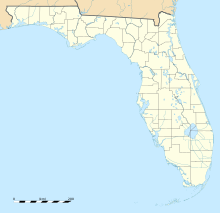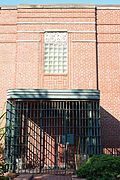
Nassau County is the northeasternmost county of the U.S. state of Florida. According to the 2010 United States Census, the county's population was 73,314. The Census Bureau estimated a population of 88,625 in 2019.

Fernandina Beach is a city in Nassau County, Florida, United States, on Amelia Island. It is the northernmost city on Florida's Atlantic coast, and is one of the principal municipalities comprising Greater Jacksonville. It is also the seat of Nassau County. The area was first inhabited by the Timucuan Indian people. Fernandina Beach is located on Amelia Island, known as the "Isle of 8 Flags", Amelia Island has had the flags of the following nations flown over it: France, Spain, Great Britain, Spain (again), the Republic of Florida, the Green Cross of Florida, Mexico, the Confederate States of America, and the United States.

Yulee is a Census county division (CCD) in Nassau County, Florida, United States. The population is currently 28,798 as of April 2018. Yulee is part of the Jacksonville metropolitan area, which was home to 1,504,980 people in 2017. Today, the Yulee CCD is a residential bedroom community for those who commute to Jacksonville, Naval Submarine Base Kings Bay, or other locations in Southeast Georgia, but is working to diversify its tax base.

Amelia Island is a part of the Sea Islands chain that stretches along the East Coast of the United States from South Carolina to Florida; it is the southernmost of the Sea Islands, and the northernmost of the barrier islands on Florida's Atlantic coast. Lying in Nassau County, Florida, it is 13 miles (21 km) long and approximately 4 miles (6.4 km) wide at its widest point. The communities of Fernandina Beach, Amelia City, and American Beach are located on the island.
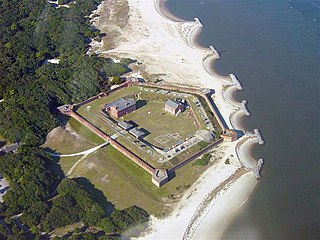
Fort Clinch is a 19th-century masonry coastal fortification, built as part of the Third System of seacoast defense conceived by the United States. It is located on a peninsula near the northernmost point of Amelia Island in Nassau County, Florida. The fort lies to the northeast of Fernandina Beach at the entrance to the Cumberland Sound, in the northeast part of the state. Today it is included within the boundaries of Fort Clinch State Park.
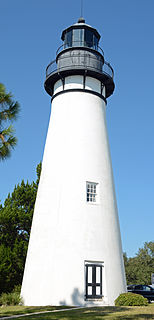
The Amelia Island Light is the oldest existing lighthouse in the state of Florida in the United States. It is located near the northern end of Amelia Island in the northeastern part of the state. Its light marks St. Marys Entrance, the inlet leading to St. Marys River, the Cumberland Sound and the harbor of Fernandina Beach, Florida along the Amelia River. The white light flashes every ten seconds which turns red from 344° to 360° when covering the shoal water in the vicinity of Nassau Sound.

The Fort Clinch State Park is a Florida State Park, located on a peninsula near the northernmost point of Amelia Island, along the Amelia River. Its 1,100 acres (4 km2) include the 19th-century Fort Clinch, sand dunes, plains, maritime hammock and estuarine tidal marsh. The park and fort lie to the northeast of Fernandina Beach at the entrance to the Cumberland Sound.

The Amelia Island North Range Light was built to mark a channel over the sandbar at the mouth of the St. Mary's River, which led to the harbor at Fernandina Beach, Florida, on Amelia Island. It consisted of a lighthouse and a front range tower with a light, arranged so that when ships could see one light above the other, they were lined up with the channel. During the Civil War Confederate forces removed the lenses from the lights. Union forces seized Fernandina Beach, Fort Clinch and the lighthouse in 1862.

The Fernandina Beach Historic District is a U.S. historic district located in Fernandina Beach, Florida on Amelia Island. The Fernandina Beach Historic District was included on the National Register of Historic Places on July 20, 1973 and encompasses approximately 1,500 acres, bounded by North 9th Street, Broome, Ash, South 5th Street, Date, and South 8th Street. On April 20, 1987, the National Register listing was expanded to include an additional 970 acres (3.9 km²), bounded by Sixth, Broome, North 3rd, & Escambia Streets; Seventh & Date Streets, and Ash. Approximately 300 buildings are included in this district.
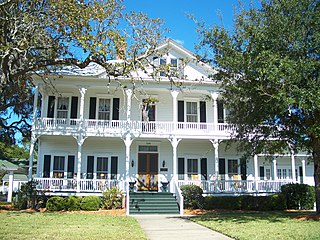
The John Denham Palmer House is a historic house in Fernandina Beach, Florida. It is located at 1305 Atlantic Avenue. On July 3, 1986, it was added to the U.S. National Register of Historic Places.
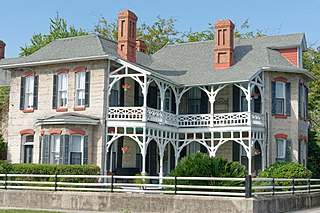
The Tabby House is a historic site in Fernandina Beach, Florida. It is located at 27 South 7th Street. On June 4, 1973, it was added to the U.S. National Register of Historic Places. R. S. Schuyler, credited as the architect, is also listed as the architect of the nearby Fairbanks House, also built in 1885.

The Original Town of Fernandina Historic Site, also known as "Old Town", is a historic site in Fernandina Beach, Florida, located on Amelia Island. It is roughly bounded by Towngate Street, Bosque Bello Cemetery, Nassau, Marine, and Ladies Streets. On January 29, 1990, it was added to the U.S. National Register of Historic Places as a historic site. Lying north of the Fernandina Beach Historic District, it is accessible from North 14th Street.
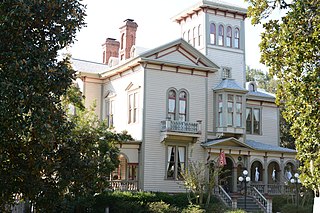
The Fairbanks House is a historic site in Fernandina Beach, Florida. It was built in 1885 for George Rainsford Fairbanks. R. S. Schuyler was the building's architect. It is located at 227 South 7th Street. On June 4, 1973, it was added to the U.S. National Register of Historic Places. Built as a surprise for his wife, it was reported not to have gone over well and became known as "Fairbanks Folly".
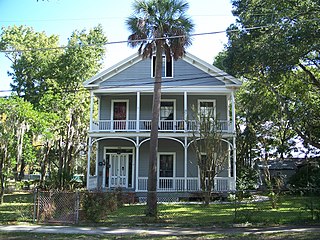
The Merrick-Simmons House is a historic house located at 102 South 10th Street in Fernandina Beach, Florida.
Fernandina Beach Municipal Airport is a city-owned public-use airport located on Amelia Island three nautical miles (6 km) south of the central business district of Fernandina Beach, a city in Nassau County, Florida, United States. It is designated as a reliever airport for Jacksonville International Airport.

The Halifax Historical Museum displays local history from 5,000 BC to the present day in a National Register of Historic Places listed building designed by Wilbur B. Talley in Daytona Beach, Florida, United States. The museum is housed in the former Merchants Bank building (1910), added to the U.S. National Register of Historic Places on January 6, 1986. It is located at 252 South Beach Street.
John M. Drew is the current Tax Collector of Nassau County, Florida. He was first appointed Tax Collector by Governor Jeb Bush in May 2006. He was elected to the office later that year.
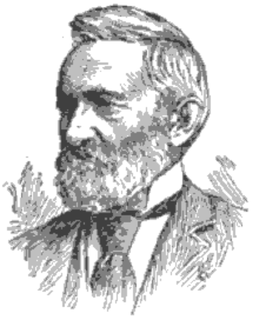
George Rainsford Fairbanks (1820–1906) was a lawyer, Clerk of the Circuit Court, Florida State Senator, president of Florida Fruit Growers Association and the Florida Fruit Exchange; editor of the Florida Mirror; the author of books on Florida history; and the founder and president of Florida Historical Society. He lived in Fernandina Beach. He is listed as a Great Floridian.
Robert Sands Schuyler, often written as R. S. Schuyler and occasionally as R. V. Schuyler, was a New York architect, designer, and religious leader who moved to Florida and joined political, religious, and civil organizations on Amelia Island. He served as Clerk of the City of Fernandina, chaired the Fernandina Library Association when it was established in 1891, and was a lay reader at the Santa Fe Lake, Florida, Episcopal congregation.

Fort San Carlos was a military structure built in 1816 to defend the Spanish colonial town of Fernandina, Florida, now called Old Town, which occupied a peninsula on the northern end of Amelia Island. The fort, a lunette fortification, stood on the southwest side of the town next to the harbor, on a bluff overlooking the Amelia River. It was made of wood and earthworks, backed with a wooden palisade on the east side, and armed with an eight or ten gun battery. Two blockhouses protected access by land on the south, while the village was surrounded with military pickets. An 1821 map of Fernandina shows that the street plan, laid out in 1811 in a grid pattern by the newly appointed Surveyor General of Spanish East Florida, George J. F. Clarke, today preserves nearly the same layout as that of 1821. The fort occupied the area bounded by the streets Calle de Estrada, Calle de White, and Calle de Someruelos. The structure itself has disappeared and only traces remain in what is now Fernandina Plaza Historic State Park.

